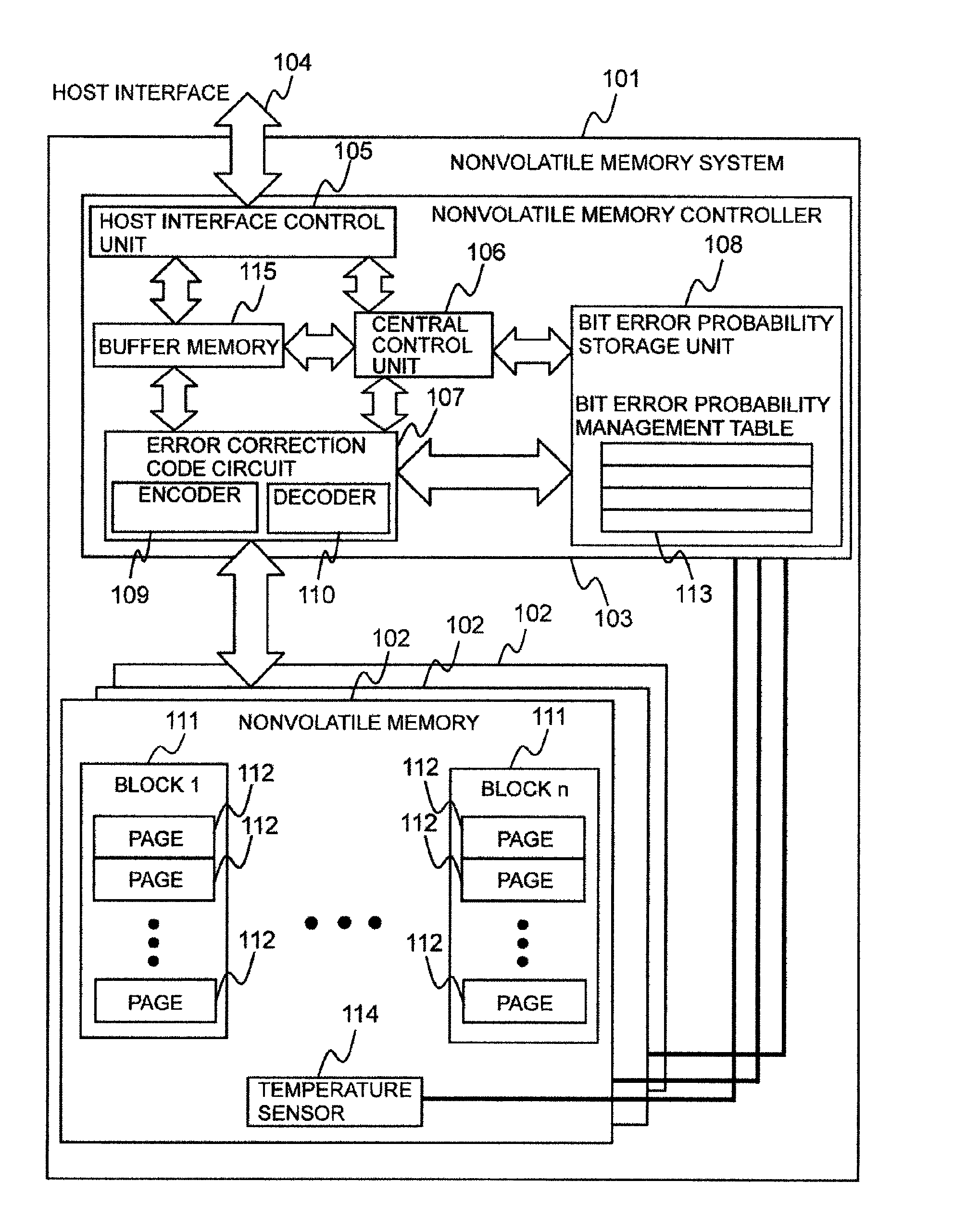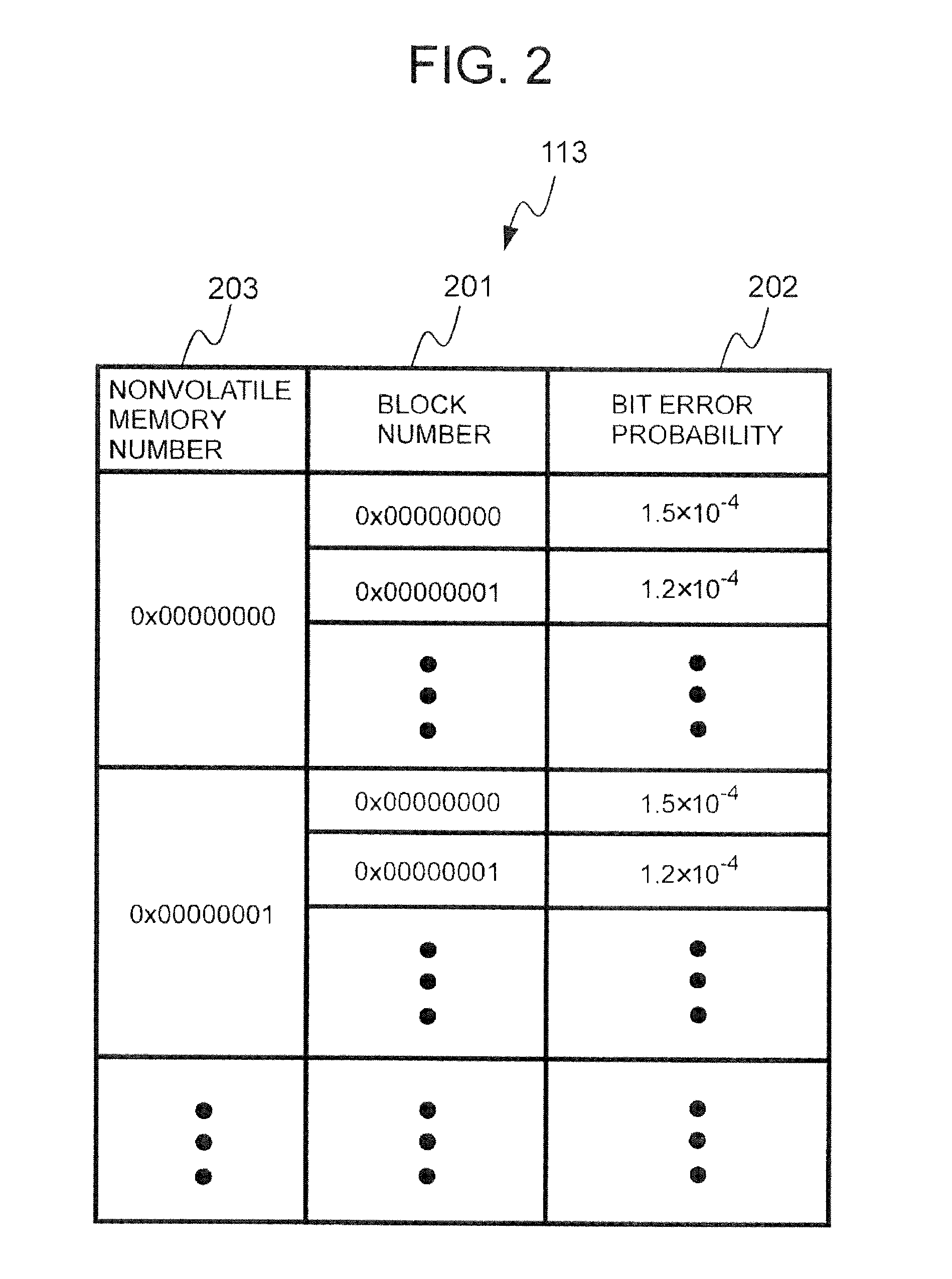Non-volatile storage system compensating prior probability for low-density parity check codes
a non-volatile storage and parity check technology, applied in error detection/correction, instruments, coding, etc., can solve the problems of program-erase tolerance, two reliability problems, and the general sacrifice of the ability to increase the capacity of flash memory
- Summary
- Abstract
- Description
- Claims
- Application Information
AI Technical Summary
Benefits of technology
Problems solved by technology
Method used
Image
Examples
example 1
[0069]FIG. 1 shows a nonvolatile memory system related to a first example.
[0070]A nonvolatile memory system 101 comprises multiple (or one) nonvolatile memories 102, and a nonvolatile memory controller 103, which is coupled to the multiple non-volatile memories 102 and controls these memories 102. The nonvolatile memory controller 103 is coupled to a host (not shown in the drawing) by way of a host interface 104. The host (not shown in the drawing) sends a data input / output command to the nonvolatile memory controller 103, and the nonvolatile memory controller 103 executes the input / output of the data to / from the nonvolatile memory 102 in accordance with this command.
[0071]The nonvolatile memory controller 103 comprises a host interface control unit 105 for controlling the host interface 104, an error correcting code circuit 107 for encoding / decoding data, a bit error probability storage unit 108 for storing a bit error probability, a central control unit 106, and a buffer memory 11...
example 2
[0099]A second example will be explained below. In so doing, the differences with the first example will mainly be explained, and explanations of the points in common with the first example will either be simplified or omitted.
[0100]The bit error probability of the flash memory is affected by the elapsed time from when data is programmed until the data is read (hereinafter, the PR elapsed time), for example, is proportional to the PR elapsed time. That is, when it is supposed that the PR elapsed time is t, the bit error probability is expressed using math (18).
p(t)=a0t+p0 [Math.18]
[0101]The a0 is a proportionality coefficient, and the p0 is an intercept. In a case where the nonvolatile memory 102 is managed in units of blocks, the bit error probability management table 113 stores the time at which the data was last programmed, the proportionality coefficient, and the intercept for each block. Numerical values obtained by experiment may be used as the initial values of the numerical...
example 3
[0134]A third example will be explained below. In so doing, the points of difference with the first example and / or the second example will mainly be explained, and explanations of the points in common with the first example and / or the second example will be simplified or omitted.
[0135]In this example, the flash memory bit error probability is decided on the basis of a number of programmings, a number of reads, and a temperature.
[0136]Programming data to a page (to include erasing) causes damage to the flash memory cell(s) inside this page and an increase in the bit error probability of this page.
[0137]Reading data from a page also causes an increase in the bit error probability of this page. This is referred to as a read disturb. When data is read from a flash memory, electrons are discharged to a small extent from the flash memory cell where the electrons are stored. In a flash memory, the distinction between the information 0 and 1 is made in accordance with states in which electr...
PUM
 Login to View More
Login to View More Abstract
Description
Claims
Application Information
 Login to View More
Login to View More - R&D
- Intellectual Property
- Life Sciences
- Materials
- Tech Scout
- Unparalleled Data Quality
- Higher Quality Content
- 60% Fewer Hallucinations
Browse by: Latest US Patents, China's latest patents, Technical Efficacy Thesaurus, Application Domain, Technology Topic, Popular Technical Reports.
© 2025 PatSnap. All rights reserved.Legal|Privacy policy|Modern Slavery Act Transparency Statement|Sitemap|About US| Contact US: help@patsnap.com



